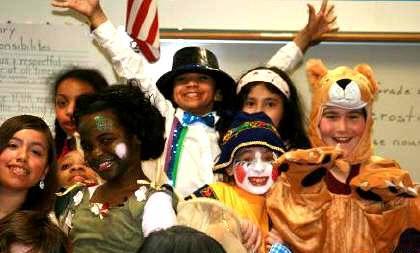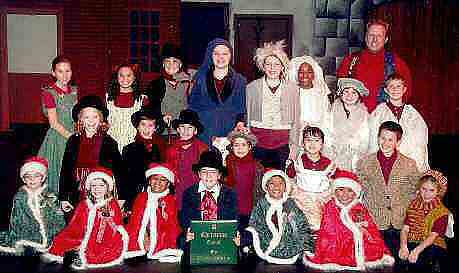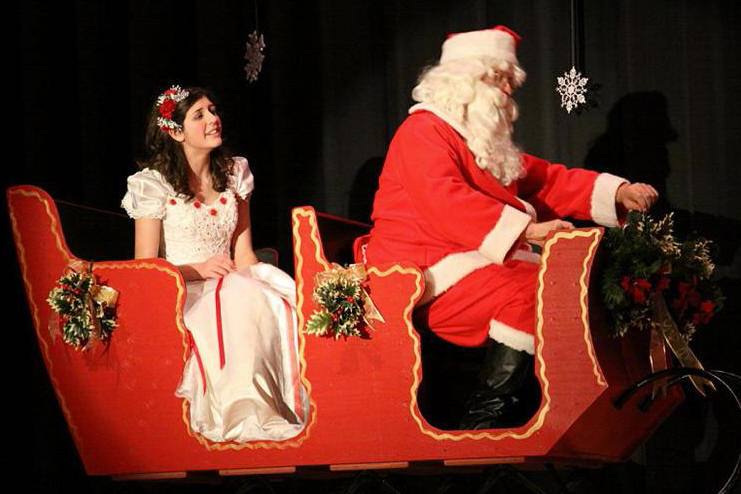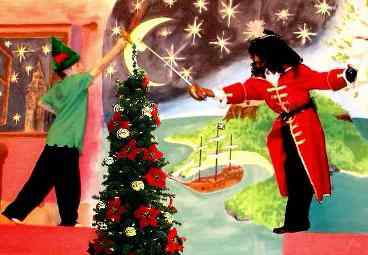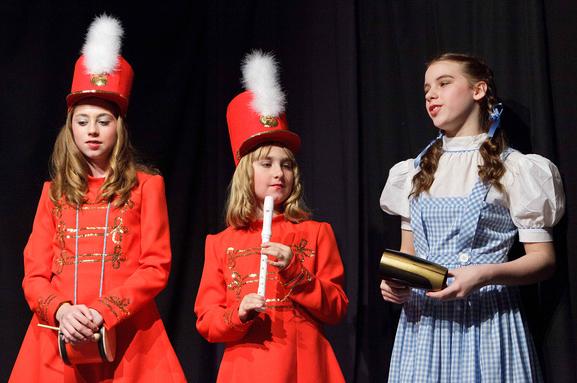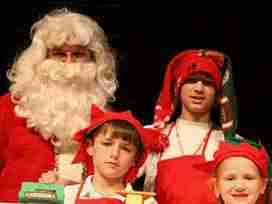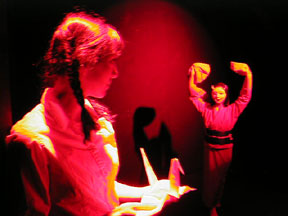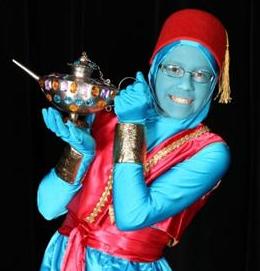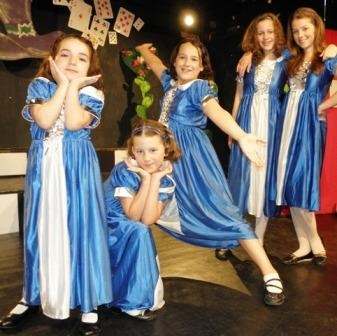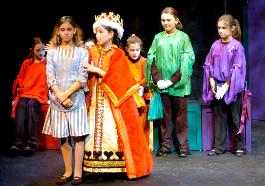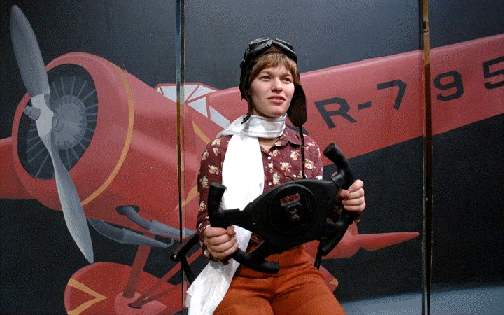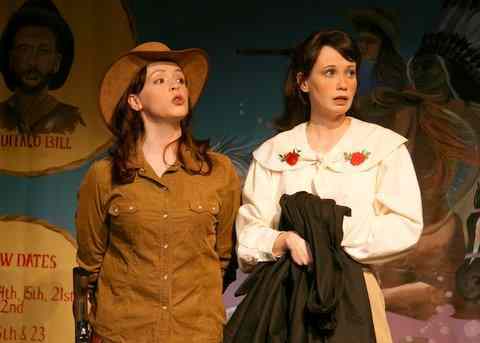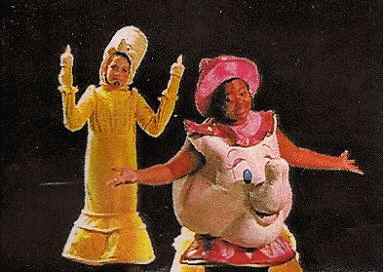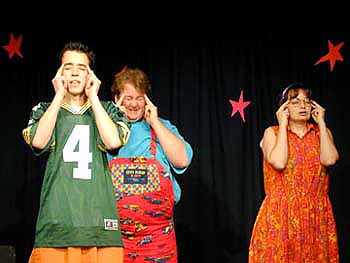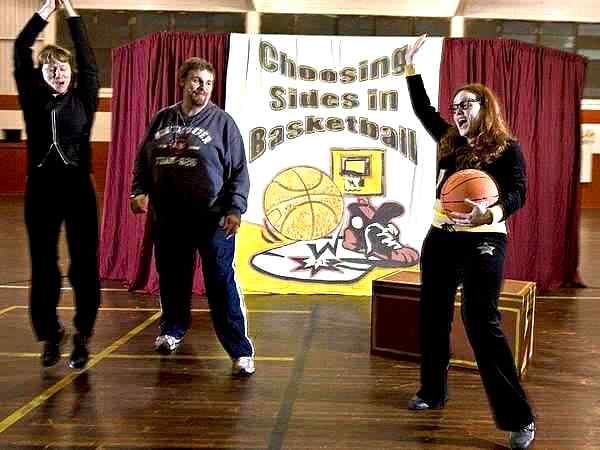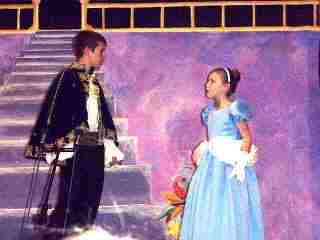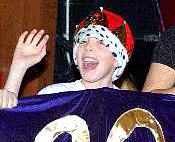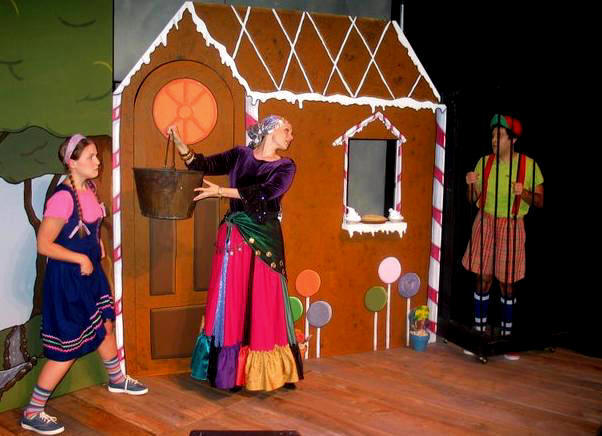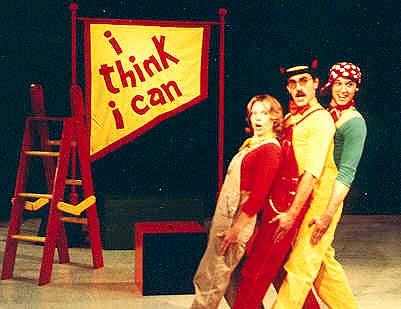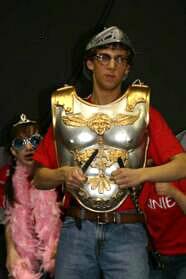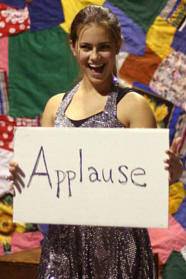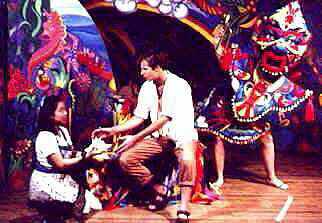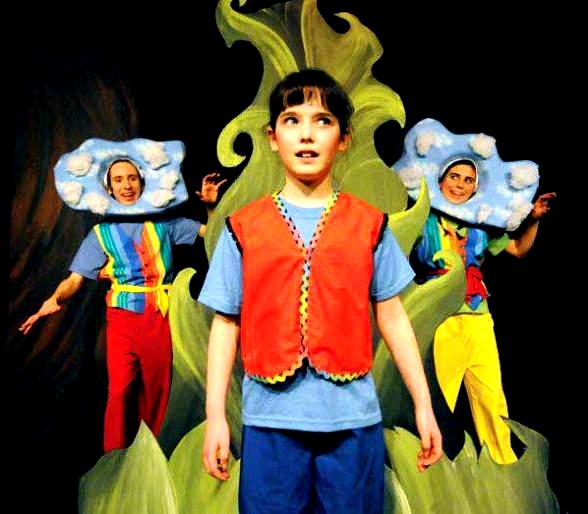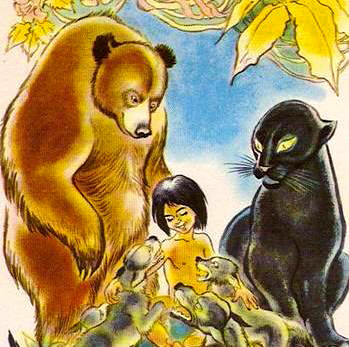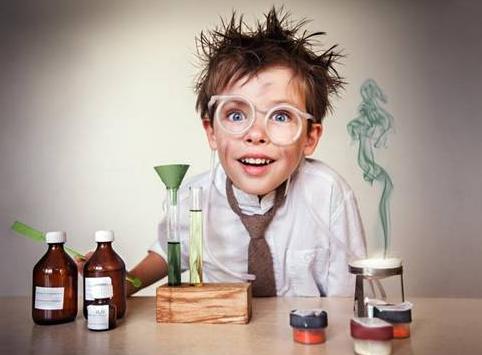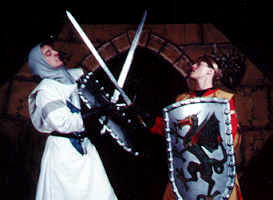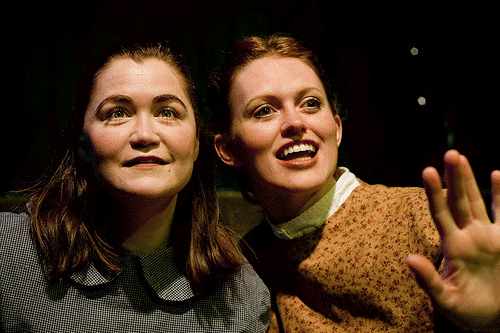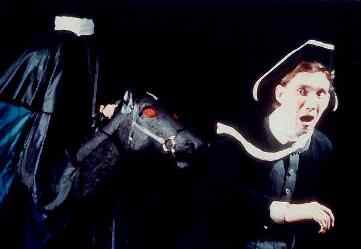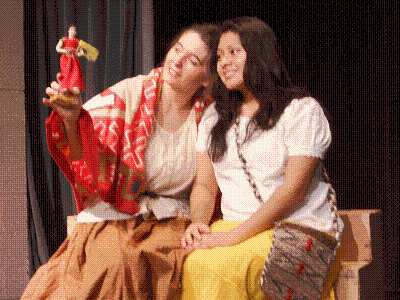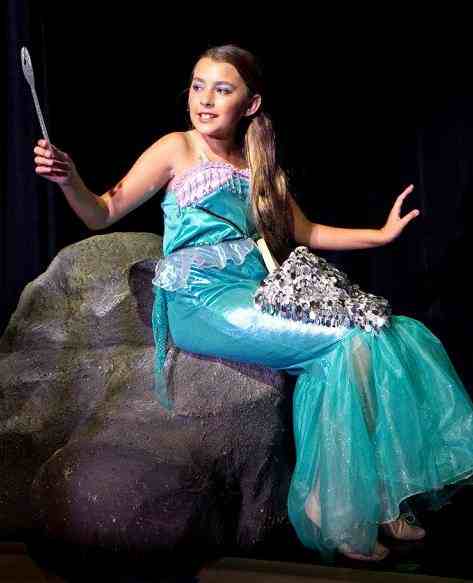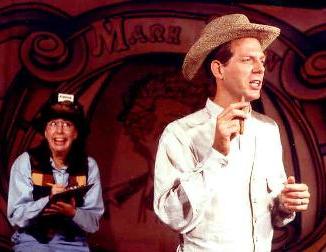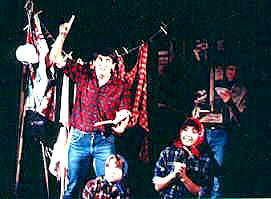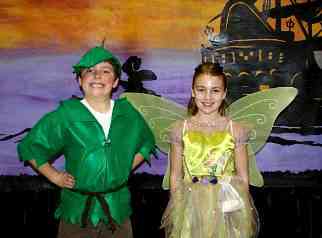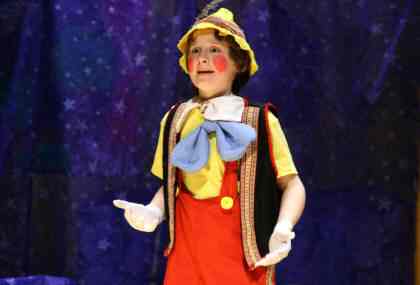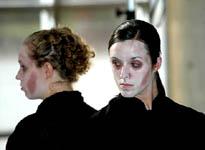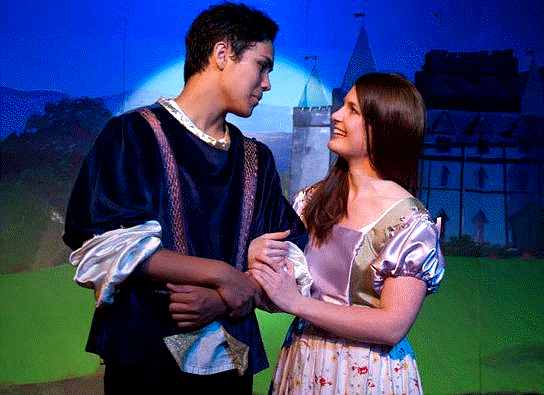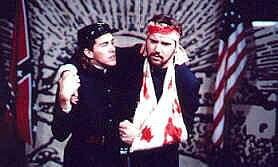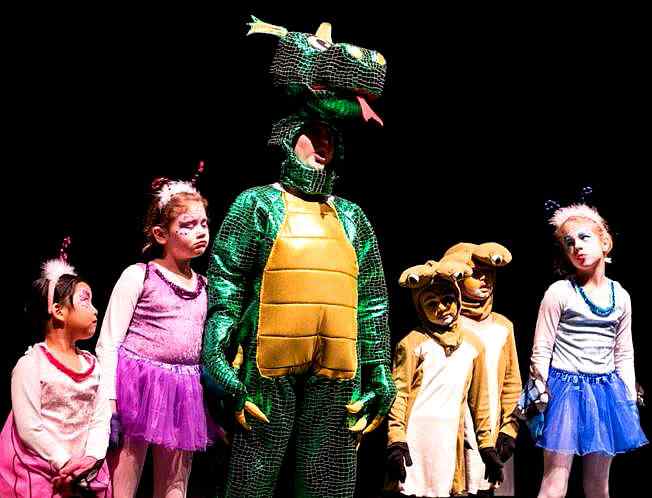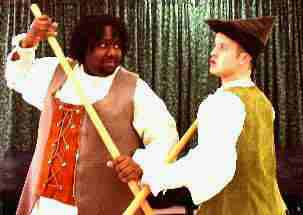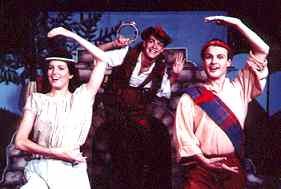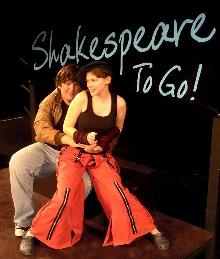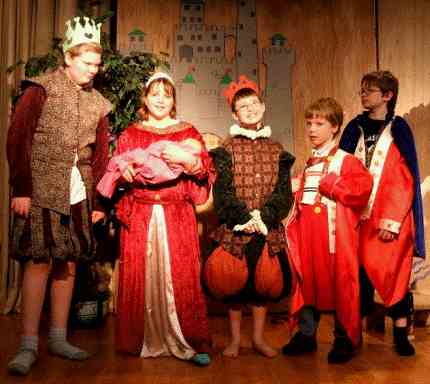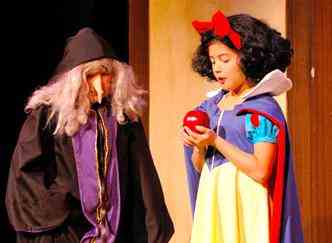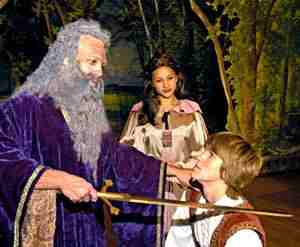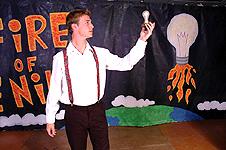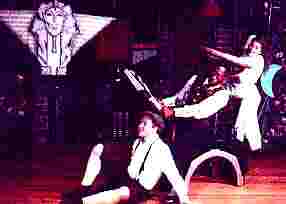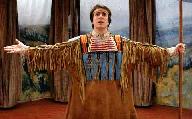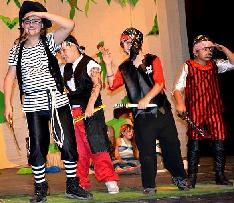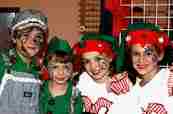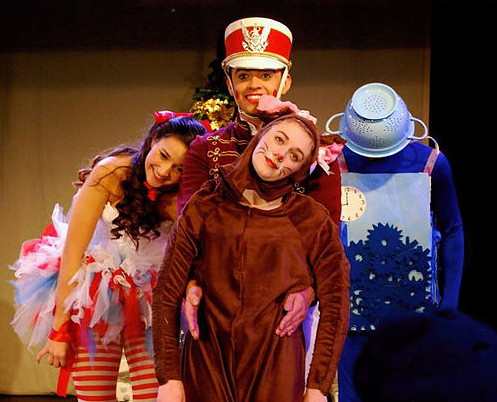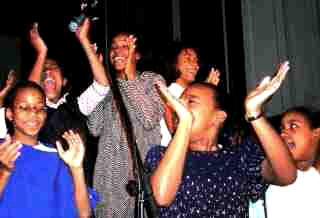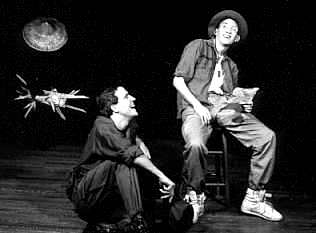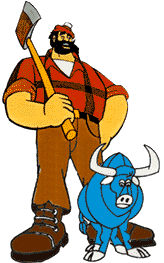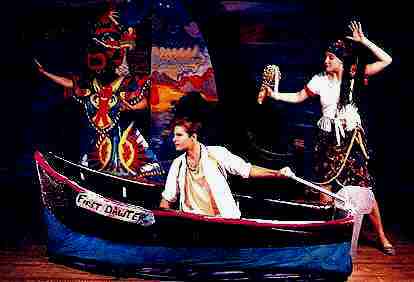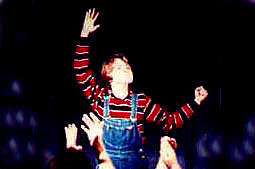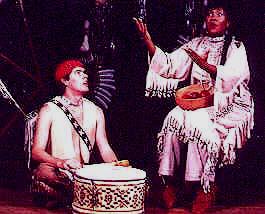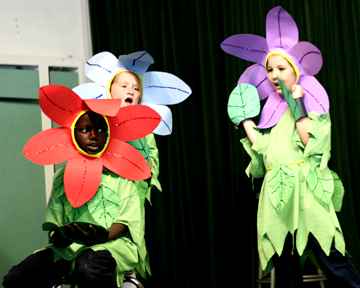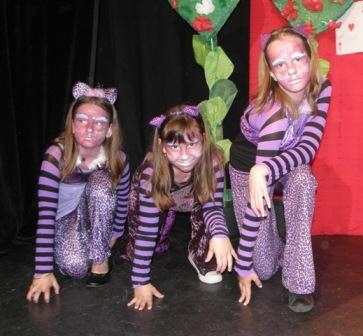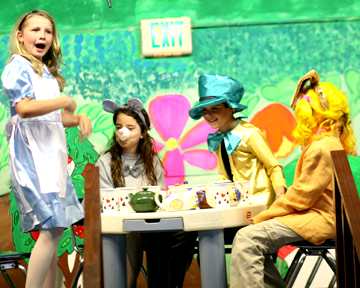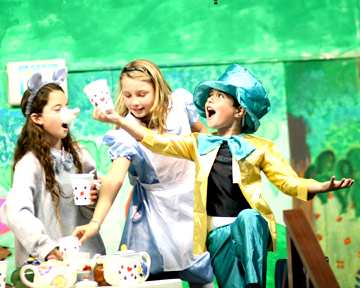Ho! Ho!
Ho! And a Bundle of Fun!
Fun Classroom Activities for
ArtReach's Treasure Island
Long John Silver’s Missing Leg:
Pirates are often depicted with missing eyes, hands or legs. It is
understood that these injuries were the result of pirate warfare.
Describe the story of Long John Silver’s life. Where was he
born? How did he become a pirate? Long John claims he lost his leg in
a noble patriotic battle for his country. Do you think this is true?
Treasure Map: Roll out a
long length of paper and draw a treasure map using your school as the
island where it is buried. Where will you bury your imaginary
treasure? On the playground, in the cafeteria, in the gym? Draw the
path to it.
Argg!
Me Hearties! Kids Love to Play Pirates!
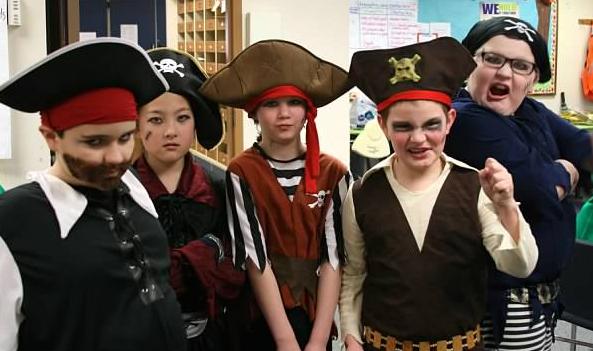
Shoultes Elementary School, Marysville, WA
Sailing a Ship:
Look at the picture of the ship in this Teachers Guide and discuss
the parts of a ship. What does each part do and why is it necessary?
Pretend you are sailor and stand up and pretend you are in the actual
ship. What will you do to get the ship out of the harbor and onto
sea? How do you land a ship on an island?
Deserted Island: If you
were left on a deserted island what 3 things would you like to have
with you? A book, a computer, lots of candy or toys? What things
would you need to survive? How would you get the things you needed?
Pirate Names: Pirates
were often given names that described their personality or something
they liked to do. What words do you think describe your personality?
Do you like to play baseball, eat pasta, talk on the phone, play
games? Use these characteristics and make up your own pirate name.
Have each student say their pirate name and the reasons for it.
Traveling on the Sea:
Pirates often spent many weeks or months on a boat out at sea. Think
about the qualities of the sea and the creatures in it. Think about
the dangers such as storm, wind, rain, heat. What kinds of animals
are in the sea? Pretend you are one of these animals and a ship is
sailing over your head. What do you think of that ship and what does
it make your creature do? Have you ever been snorkeling in the ocean?
Describe what it is like under the sea.
Becoming a Hero: Jim
Hawkins has a fantasy of sailing on the ocean. What is your fantasy?
Would you like to climb mountains, fly to the moon, climb redwood
trees? Think of the place in the world or beyond and describe it by
writing it all down on paper. What grows there? What do you eat
there? What kind of clothes do you wear for your adventure? Do you
have to fight any enemies there? Write a story about your fantasy
adventure starring yourself as the hero.
Becoming a Hero!
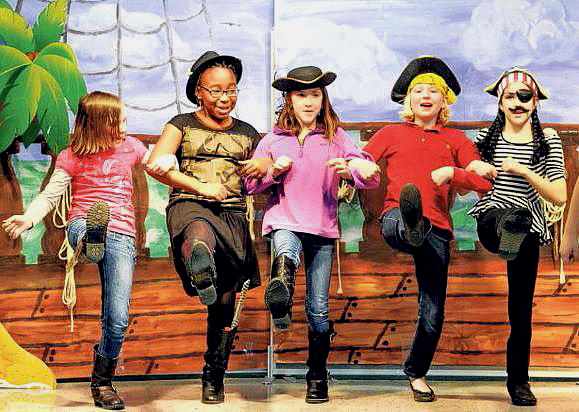
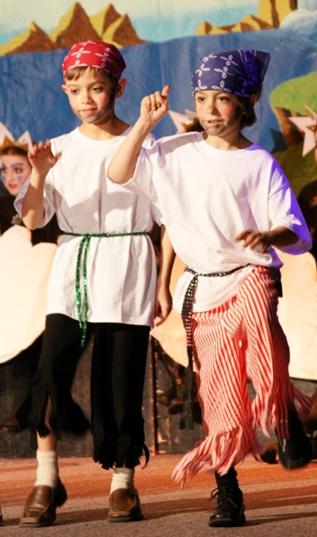
Rockfish, Lynchburg, VA - Newport Heights,
Bellevue, WA
Pirate Names: Pirates
were often given names that described their personality or something
they liked to do. What words do you think describe your personality?
Do you like to play baseball, eat pasta, talk on the phone, play
games? Use these characteristics and make up your own pirate name.
Have each student say their pirate name and the reasons for it.
Traveling on the Sea:
Pirates often spent many weeks or months on a boat out at sea. Think
about the qualities of the sea and the creatures in it. Think about
the dangers such as storm, wind, rain, heat. What kinds of animals
are in the sea? Pretend you are one of these animals and a ship is
sailing over your head. What do you think of that ship and what does
it make your creature do? Have you ever been snorkeling in the ocean?
Describe what it is like under the sea.
General Classroom
Activities
Creative dramatics
exercises
& games
Mirror:
Have the students pair up (any one without a partner gets to go with
the instructor!). In each pair, decide who will be the
"leader" and who will be the "reflection" first.
The reflection must duplicate all actions by the leader. No speaking
is allowed. The leader should not try to trick or confuse the
reflection. At a particular time (after a couple minutes or so) the
instructor claps or otherwise signals that the partners should
reverse roles.
Freeze:
Have two students begin an improvised scene of action that requires
teamwork (washing a car, making cookies, etc). After a minute or so,
or as soon as they've gotten "into" the routine, the
instructor claps or otherwise signals them to come to a complete stop
- freeze!. Either choose someone or ask for a volunteer to take the
place of one of the two frozen actors. When in place, the new actor
will begin a completely new and different action that evolves from
the frozen pose. [For instance, waxing a car could evolve into
petting a dog] This repeats until imaginations run dry.
Pantomime:
Explain pantomime to children as acting without words or props. It
combines elements of theater and works best with a strong script or
actions and allows the actors to "talk" without speaking.
The secret is to exaggerate everything and move in slow motion.
For simple
pantomime activities, pick kids and ask them to pretend they are
doing, say, sports activities. The kids in the audience should try to
guess what the "actor" is doing. If possible, have enough
activities so that every child has an opportunity to pantomime.
·
Lifting weights
· Bowling
·
Throwing a baseball
·
Dribbling a basketball
·
Serving a tennis ball
·
Eating foods they might get at a game, like hot dogs, peanuts,
popcorn, etc.
Try a
scripted pantomime with older kids. Some scripts are available
(usually for a small fee) on the Internet but older kids can easily
develop their own script from simple fairy tales and traditional
stories, such as "The Tortoise and the Hare."
Improvisation:
For improvisational dramatics, the actors do not have a script and
they perform spontaneously. The unpredictability lends itself
especially well to comedy. You do not need a script or prepared
scenes, but detailed instructions and improv game ideas are available
in Funny Bones: Comedy Games and Activities and On Stage: Theater
Games and Activities for Kids, both written by Lisa Bany-Winters.
Classroom
Activities
General Preparation for 'Alice
in Wonderland'
Talk about theatre and what a play is.
What other plays have you seen? Describe them to the
class. Why do you think certain parts of those plays are
memorable to you. What do you expect this play will be
like? What is the difference between seeing a play on
television or movies and seeing actors perform it live?
Read the synopsis in the Teachers Guide and
discuss the story. You may also want to read the book by Lewis
Carroll. Can you find Wonderland on the map? Why
not? Why do you think all the characters in the story act the
way they do? Who is your favorite character and why?
Talk about how Lewis Carroll had to use his
imagination to make up all the strange things that Alice encountered
in Wonderland. Can you make up crazy characters and animals
like that? Think of animals you know like a bird or a
horse. Now give the animal special characteristics. Is
you animal selfish or wise? Handsome or silly? Is he
hungry or hot or happy or skinny? Where does he live?
What does he where and eat? What kind of sounds does he
make? Can he talk?
Name your animal. Can you pretend to be
your animal and introduce yourself to the rest of the class?
Can they guess what kind of animal you are without telling them?
If they can, they you have just become a great actor! (This is
a great exercise to later help in the role selection process).
Roll out some plain wrapping paper and make a
group drawing of Wonderland. Show the path Alice took and draw
the characters she met along the way: White Rabbit, Pigeons,
Caterpillar, Cheshire Cat, Mad Hatter, Gardeners, Queen of Hearts,
Flamingoes, etc. You can even make the drawing real big and use
it as a backdrop for the performance!
Imagination: A Wonderland All
Around Us
Objective: Help
students understand the importance of imagination, creativity and the
creative arts - for everyone, children and adults alike. Just
like Alice's adventure, imagination is a Wonderland all around us.
Activities: Have
the class reflect on the familiar story of Alice In Wonderland.
Use the synopsis in this guide (or another source), view the
video, or simply discuss the story as you and they know it.
· Ask students to write a summary of the
story (50-100 words).
· Allow students to read their summaries
to the class.
· Ask students to draw their favorite
character or scene (and tell why they picked that character - can
combine with summary story, above - helpful in assigning roles in the play!).
· Display all the drawings (great as a
guide for costume and set design!).
· Ask students to name (or draw)
the "real life" characters (Lewis Carroll, Alice, what
about all five Alices!).
· Ask students to name (or draw) the
"imaginary" characters from Wonderland (White Rabbit,
Cheshire Cat, Caterpillar, Mad Hatter, Dormouse, March Hare, Queen of
Hearts, etc.)
Discussion / Questions:
Have a class discussion about what it would be like to suddenly fall
down a deep hole (or walk through a door, or crawl under a bed&ldots;)
and end up in a strange place - a make-believe place - like Wonderland.
Do you think there's actually a strange,
magical place like Wonderland?
(There was for Alice! Wonderland is an
imaginary place created by the man who wrote the story, Lewis
Carroll. Even Alice and all the characters in the story are
imaginary [though Alice was based on a real-life Alice]. But
isn't imagination a wonderful thing? Without it we wouldn't
have wonderful stories like Alice In Wonderland, The Wizard of Oz,
Peter Pan, Cinderella.)
Can you think of your own magical place?
What would you call it?
Who would live in your magic land?
(You? Me? White Rabbits? Squawking
Flamingos? Space aliens? Dinosaurs? Green elephants? Hump
back camels and chimpanzees? Unicorns?)
Can you grow nineteen feet tall? Or
shrink to three inches?
(No, but maybe you can imagine what it would
be like to be the tallest person in the world? Sometimes the
only way we can "do" something is to imagine doing it.)
Continue the discussion&ldots;
What would it be like if we couldn't imagine
fun or silly or impossible things?
If we couldn't play? If we had to be
serious and real all the time?
Even adults like to imagine fun things, don't
they? (Ask the teacher)
So even though we can't really do everything we
want to, sometimes we can be like Alice by using our imaginations to
create a Wonderland where anything is possible - by writing stories,
painting pictures, telling tales, playing games&ldots;
Or performing a play.
Theatre
Games for the Classroom
Fun Games
for Elementary / Primary School Students
Painting the
Music Game
Everyone
find a comfortable spot and sit. Imagine you have a big easel in
front of you, with a new blank canvas on it. In your hand is a
palette with every color of paint you can think of. Select any
type of music to play for the exercise - we suggest using the various
selections on the CD Soundtrack (the pre/post-show music).
(Start
the music.) Listen to the music. Listen especially to the
feelings in the music. How does this music make you feel? What do you
think it is about?
As you
listen to the music, begin to paint what you hear. Some of you will
paint pictures, but some of you will probably just paint colors and
shapes. Whatever you hear is what you should paint.
Really
listen! Listen to the changes in the music. Listen for characters and
listen for events. Whatever you hear, that's what you paint.
These
paintings are really starting to look good!
(When the
music comes to an end.) Let's all finish up our paintings now.
They really look fantastic. Everyone take your painting over to a
wall and hang it carefully. Then return to your seat.
With
Kindergarten and younger, it only takes about five minutes of music
before the paintings are done. Older or more deliberate children can
take much longer. Use your best judgment.
Fruit Bowl
(Anyone Who) Game
Class
in a circle, each child sits on a chair.
Teacher is
in the middle and explains the rules of the game.
Students
think of four things (e.g. anyone who had breakfast, anyone who likes
rap music, anyone who has a watch on, anyone who watches a particular
TV program).
When the
person (student or teacher) in the middle calls out something you
have on, have done, have seen etc., you must leave your chair and
move to another one, BUT YOU MUST NOT SIT ON A CHAIR ON EITHER SIDE
OF THE CHAIR YOU ARE PRESENTLY SITTING ON.
The person
left without a chair (the teacher is participating) becomes the
person in the middle, calling out the next criteria for moving. The
person in the middle must speak quickly and clearly.
VARIATIONS:
Students crawl, moonwalk, walk backwards (start with hands on
chairs), run, twist, skip, jump to chairs.
Magician's
Power Game
The teacher
takes on the role of the almighty powerful Magician who holds in his/her
hands the most potent power of the universe (the Magician's hands
and arms begin to shake with the awesome power and he/she begins to
hum, slowly making it louder and louder).
Meanwhile
the students who have been seated in a circle begin to hum also.
The Magician
explains hat he/she is going to send the power to other magicians,
but warns that those magicians seated either side of the one holding
the POWER will be shrivelled if they don't protect themselves by
raising the hand and placing it on the cheek nearest to the person
holding the POWER.
The POWER is
passed by throwing it with great force to another whilst calling out
their name
Noises
accompany the passing of the power, such as room ro shhooom.
Every time
someone is shrivelled, he/she leaves the circle.
The winners
are the last two magicians.
Trust Run Game
Students are
in pairs.
Students
line up like a race, one partner behind the other, facing the finish
line which the teacher has marked out.
The person
behind closes his/her eyes and holds onto the hands of the person in front.
The teacher
says "Go!" and the students race off. Once they reach the
line they swap places and race back. The most difficult thing is to
keep your eyes closed.
Fun
Activities & Ideas for A Christmas Wizard of Oz
Taking a Step Closer to A
Christmas Wizard of Oz
Science
Study cyclones, tornadoes,
blizzards etc. You may want to make your own - When the cyclone hits,
Dorothy and her house travel in the storm. You can make your own
version of a cyclone with two soda bottles, some water, a little
glitter and some duct tape. Fill one of the bottles with water and a
small amount of glitter. Tape the two bottles securely together at
the openings. Flip the full bottle to the top position and swirl them
so that the water forms a whirlpool or cyclone as it flows into the
other bottle. You may also want to get out the encyclopedia (or
library books) to learn about cyclones and weather in general. Learn
about rust. What causes rust? What can be done to prevent it?
Is That
Santa's Reindeer in the Sky?
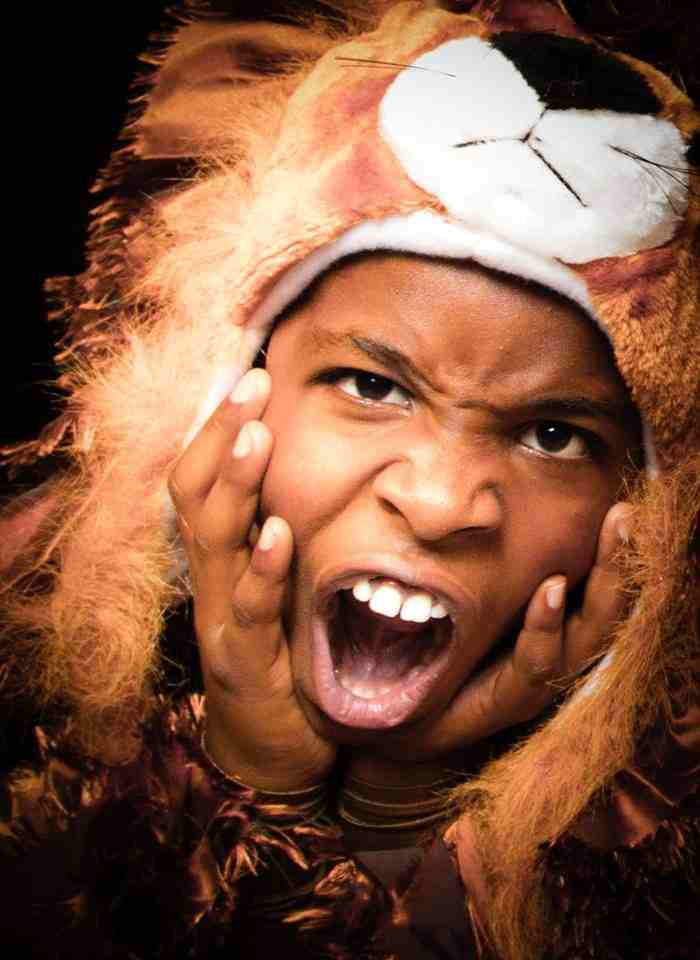
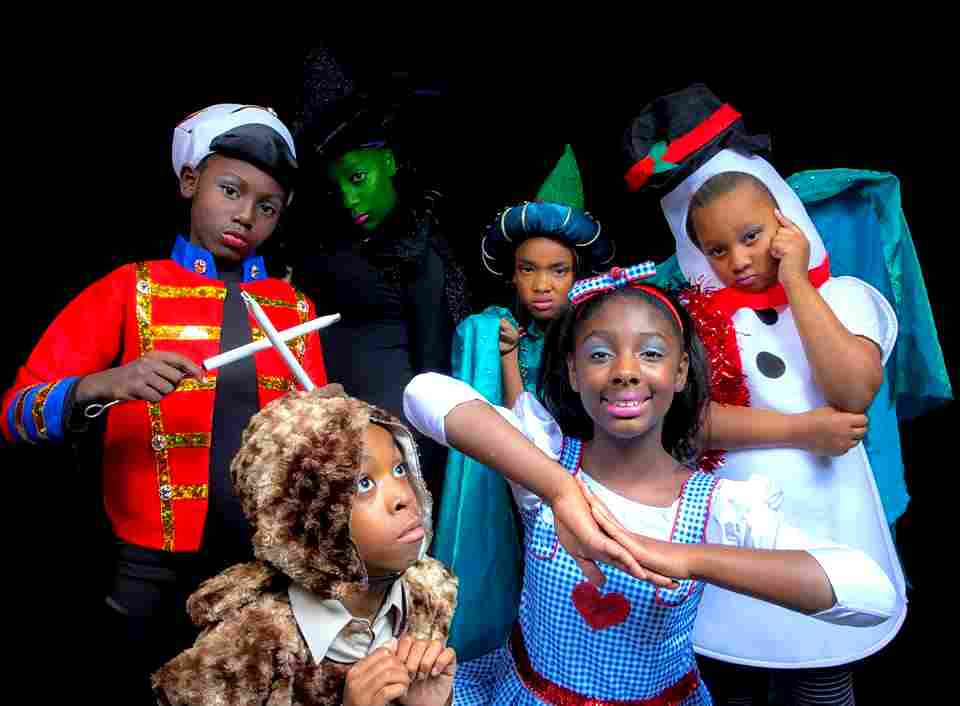
Stuffed Lion and Toy Friends, The Rhodes
School, Houston TX
Geography
Get out an encyclopedia about
Kansas (or library books). Learn about the climate, the weather and
the people of Kansas. You may also wish to make a map of Kansas. Talk
with your child about the words North, South, West and East. Label
four walls of a room with these words. This would be a great time to
teach your child how to use a compass. As you drive around town, talk
about the directions that you are traveling.
Health
Learn about the heart and the
brain. Talk about the importance of each organ. Can we live without
either of them?
Creative Writing
Have your child write a story
with themselves as the main character. In the story, have them go to
a strange land through a strange mode of travel and describe all of
the unusual people and the weird things they do while
there. Write a biographical sketch of at least three of
the characters in the book, "Wizard of Oz." Compare
and contrast two or more characters in the book. You may take this a
little further and do the compare/contrast exercise with the same
character, comparing the character as they appear in the book and as
they appear in the movie. Compare/contrast the book and the
Warner Brothers movie staring Judy Garland. My preference would be to
watch the movie AFTER reading the book, but this is up to you.
Math
Figure out how long after the
story was written that the movie was released. How many numbers you
can find while reading the book?
Drama
Have your child create a play
based on the book. Create costumes for characters in the story,
by drawing or sewing. Recite portions of the book, using correct
pronunciation, diction, voice inflection, etc. Create scenery
for your play.
